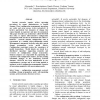Free Online Productivity Tools
i2Speak
i2Symbol
i2OCR
iTex2Img
iWeb2Print
iWeb2Shot
i2Type
iPdf2Split
iPdf2Merge
i2Bopomofo
i2Arabic
i2Style
i2Image
i2PDF
iLatex2Rtf
Sci2ools
86
Voted
DANCE
2002
IEEE
2002
IEEE
Towards Self-Configuring Networks
Current networks require ad-hoc operating procedures by expert administrators to handle changes. These configuration management operations are costly and error prone. Active networks[2, 3] involve particularly fast dynamics of change that cannot depend on operators and must be automated. This paper describes an architecture called NESTOR that seeks to replace labor-intensive configuration management with one that is automated and softwareintensive. Network element configuration state is represented in a unified object-relationship model. Management is automated via policy rules that control change propagation across model objects. Configuration constraints assure the consistency of model transactions. Model objects are stored in a distributed repository supporting atomicity and recovery of configuration change transactions. Element adapters are responsible for populating the repository with configuration objects, and for pushing committed changes to the underlying network elements. NE...
Computer Networks | Configuration Management | Configuration Management Operations | DANCE 2002 | Labor-intensive Configuration Management |
Related Content
| Added | 14 Jul 2010 |
| Updated | 14 Jul 2010 |
| Type | Conference |
| Year | 2002 |
| Where | DANCE |
| Authors | Alexander V. Konstantinou, Danilo Florissi, Yechiam Yemini |
Comments (0)

